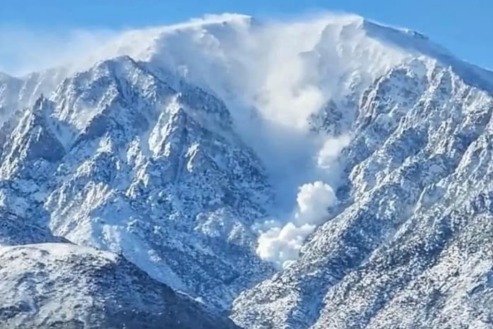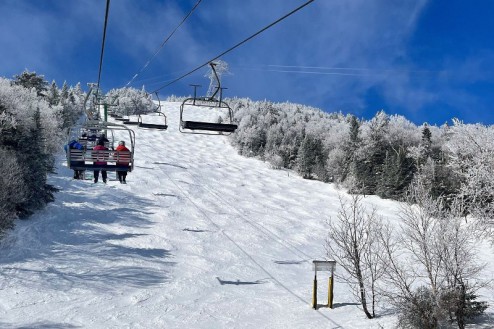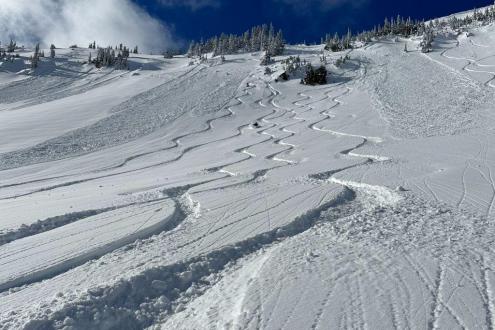Who got the most snow in North America in 2022-23?
Guest feature by Tony Crocker, 2 November 2023
2022-23 was the sixth highest snowfall season in North America's ski areas since 1976, with 117% of its long-term average snowfall, far behind only the 2010-11 season.
2022-23 was also the third consecutive La Niña season since 2020-21, though its snowfall did not reflect the usual La Niña pattern. Record-high snow fell in Utah and some of California, with well above average snowfall in the adjacent states of Oregon, Idaho, Wyoming, Arizona and western Colorado. However, snowfall was average or lower than average in western Canada, Washington, Montana, Front Range Colorado and New Mexico.
California
California's 2022-23 season got off to a fast start, with a metre of snow falling during the first half of November, quickly followed by further 1m snowfalls during the first, second and fourth weeks of December. The Sierra was then pounded with 4m of snow during the first three weeks of January.
The next month was quieter, with only 70cm of new snow, however the atmospheric rivers soon resumed, with 3m falling in late February and early March. After another 3 to 4m of snow fell during the rest of March, several areas had already set season snowfall records.
April and May were then mostly dry, but Palisades Tahoe was able to remained open into July and Mammoth well into August. However, thanks to a drier than normal spring and hot summer, less snow was left in the latter when it closed on 6 August than on the same date back in 2017.
Overall, California’s season saw 177% of its average snowfall (the prior record being 168% in 1983) with record highs at region leader Sugar Bowl (20.2m, 188%), Bear Valley (17.1m, 190%) and Mammoth (18.1m, 199%). Heavenly’s upper site saw 15.0m (156%), while Palisades Tahoe (formerly known as Squaw Valley) saw 18.3m (170%) and Kirkwood 18.4m (157%).
Utah
Utah's season was even more impressive than California’s, seeing 163% of its long-term average snowfall, blowing away the previous record of 136% set in 1984.
The season started with up to 2m of falls in late October/early November and another 2m between late November and mid-December. It then snowed 1m over the holidays and another 1m in each of the first two weeks of January.
Over the next month the pace slowed to “only” 1-2m, but it then dumped 2m in late February, 4 to 5.5m in March and 1.5m during the first week of April. Many areas extended their season a couple of weeks to the end of April as a result.
The rest of the spring was warm and dry, so Snowbird closed on 18 June, over two weeks earlier than its 4 July closure in 2005, 2011 and 2019, ending its season with 19.9m (158% of its average snowfall). More records were set at Brighton (21.9m, 168%), Solitude (20.5m, 170%), Snowbasin (15.7m, 191%) and Park City (13.2m, 177%). Alta's 22.9m (172%) was a Utah record (dating back to at least 1946) and the highest snowfall anywhere in North America in over a decade.
Colorado (and New Mexico)
Colorado's Front Range/I-70 resorts had an average early season with Steamboat, Vail and Winter Park over three quarters open before Christmas, but other areas not until New Year’s. The biggest storms (1 to 1.5m) fell in late January. February saw only half its normal snowfall, while the later months were average, with the season overall ending up at 98% of its long-term average.
Steamboat was the leader with 11.5m (123%), while snowfall totals were 8.2m in Breckenridge (92%), 8.6m in Vail (96%) and 6.4m in A-Basin (82%), the latter remaining open until 4 June.
The Southwest had a similarly average early season, with only Wolf Creek in full operation before Christmas and most other areas opening the majority of their terrain by New Year’s. January and March were big months, with 3m of snow falling at Wolf Creek and an average of 2m elsewhere.
Overall, the season saw 112% of its long-term average snowfall, despite February and April being below average. Snowfall totals were 12.6m in Wolf Creek (126%), 7.6m in Aspen Highlands (116%), 8.5m in Crested Butte (131%) and 6.2m in Taos (97%).
The Northeast
The Northeast had another poor early season due to excessive rain, with ski areas less than half open through mid-January. The second half of January finally allowed most terrain to open, thanks to up to 1m of snowfall and colder temperatures.
February saw variable snow quality, but the the highlight of the season was the first half of March, thanks to over a metre of snow. Spring was then warm with rain, although most terrain remained open through the first week of April.
Overall, the season saw 84% of its long-term average snowfall, led by Jay Peak with 7.4m (91%). Snowfall totals elsewhere included 5.0m in Killington (83%), 4.4m in Sugarloaf (101%) and 6.1m in Le Massif (100%).
US Northern Rockies
The US Northern Rockies had a strong start to the season, with 2-3m of snow falling by mid-December, and full operation for the holidays.
January and February each brought 2m of snowfall to the Tetons, but only half as much further north. March snowfall then averaged 2m across most of the region, except near the Canadian border.
After a below average April, the season finally finished at 110% of its long-term average. Grand Targhee led the region with 15.4m (130%), while Jackson Hole had 11.4m (121%), Big Sky 8.5m (113%) and Sun Valley 6.3m (125%).
The season saw much less snow near the Canadian border, where Whitefish had 5.4m (66%) and Schweitzer 7.2m (99%).
Interior Western Canada
Interior Western Canada saw around average snowfall in the early season, allowing most areas to be in full operation by New Year’s. The Banff area, however, was only about two thirds open.
January then had less than half its average snowfall, although it was followed by a snowy February (the only month with well above average snowfall in the region). March and April were then below average, leaving the season overall ending at 91% of its long-term average - the lowest ever snowfall for a La Niña season.
Big White led the region with 8.6m (118%), while Revelstoke had 7.6m (83%), Fernie 7.5m (80%) and Lake Louise 4.2m (95%).
Pacific Northwest
The Pacific Northwest saw close to average early season snowfall, though its ski areas did not reach full operation until New Year’s due to some rain episodes, notably right before Christmas.
Snowfall was below average in January and the first half of February. Then, from mid-February through March, it snowed over 4m in Oregon but about 2m further north. April then saw average snowfall and the season total ended up at 100% of its long-term average.
Snowfall totals were 9.4m in Whistler (89%) and 13.1m in Mount Hood (113%). Crystal Mountain had 9.3m (89%) and remained open to 21 May, while Mount Bachelor had 11.9m (122%) and was open until 29 May. Mount Baker led the region with 15.3m (92%).
Tony Crocker is an award-winning snow-sports journalist
and founder of www.bestsnow.net - the definitive guide to weather
and snowfall patterns in North American Ski resorts.
Read more about him here
If you enjoy reading our updates - please feel free to support us:







